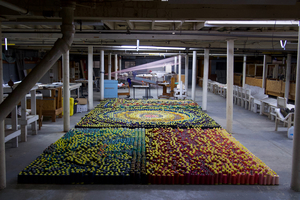
ENGAGE Projects has announced The Residue of Labor, a site-specific exhibition by St. Paul-based multimedia artist Chris Larson.
The exhibition will be presented across two locations: Larson will debut a primary, large-scale installation at an offsite warehouse in Chicago's West Town neighborhood (401 N Paulina St), in addition to a small presentation of works at ENGAGE Projects (864 N Ashland Ave). At the offsite location - a 10,000 square-foot warehouse in Chicago's West Town neighborhood - Larson's large-scale, site specific installation will include 55 recent works ranging from sculpture, video, drawing, painting, and photography, as well as an immersive work titled Thread Room.
The Residue of Labor will be on view from April 8 through May 21, 2022, and will open with a public reception for the artist on Friday, April 8, 2022, from 6-8 PM, at the exhibition's offsite venue (401 N Paulina St).
Larson's ongoing work, The Residue of Labor, first began in 2018. Funded by the Guggenheim Artist Fellowship, The Residue of Labor is a culmination of Larson's longtime engagement with a defunct American garment factory in rural Tennessee that once produced clothing for brands such as
Ralph Lauren, Burberry, and others. Utilizing the bygone factory as a point of departure, Larson creates an intimate yet immersive body of work from the forgotten materials and disused spaces within the factory, imbuing each with new life and meaning.
Among the works on view in the exhibition are examples from Larson's Thread Works series. To create the Thread Works, Larson built a foot treadle-operated machine which wrapped canvases vertically in thread with both technological precision and the randomness of a human-generated frequency simulating the physicality of the foot peddle of a sewing machine. Although created by machine, Larson asserts his hand in each work, challenging the processes and mechanisms of mass production.
Using discarded employee time cards and thread recovered from the abandoned garment factory, Larson's Timecard series (2021) conveys the residue of labor by creating depth through layers of erasure. These works bear the weight of exertion in their charged materiality and fatigued treatment. Larson uses rotary tools to emulate the effacing of history by removing material on the surface of each piece, common throughout Larson's practice.
In this exhibition, Larson also presents the video work, The Stillness of Labor (2022). In the film, Larson's perspectival disorientation animates the banality of the labor that once took place within the factory. Recreating 12 full-scale rooms from the original garment factory, Larson emulates the utilitarian workspace while gesturing to the absence of the human body that was once integral to the space.
The largest work in the exhibition, Thread Room (2022) invites viewers to walk amidst thousands of shelved spools of thread. Arranged by color to create the impression of light filtering into a room, the installation functions as a library of labor that archives the great number of jobs unceremoniously taken from rural communities when garment labor became predominantly outsourced in the late 90s. The shallow shelving in Larson's design calls upon the factory's low basement ceilings, and the stacked spools offer a visual representation of workers operating within cramped quarters, creating an immersive experience for viewers.
Invested in the relationships between individual and architecture, body and machine, Larson contemplates the history of the American garment industry and human labor that has steadily faded from many rural communities."The objects found in the factory magnify the complex relationships between intensive labor, working conditions, purpose and meaning, and what happens when these things disappear," Larson states. "[The residue of this space] aids in the investigation of class and identity, transcending their material function and pointing us toward answers of possibility."

Comments
To post a comment, you must
register and
login.


